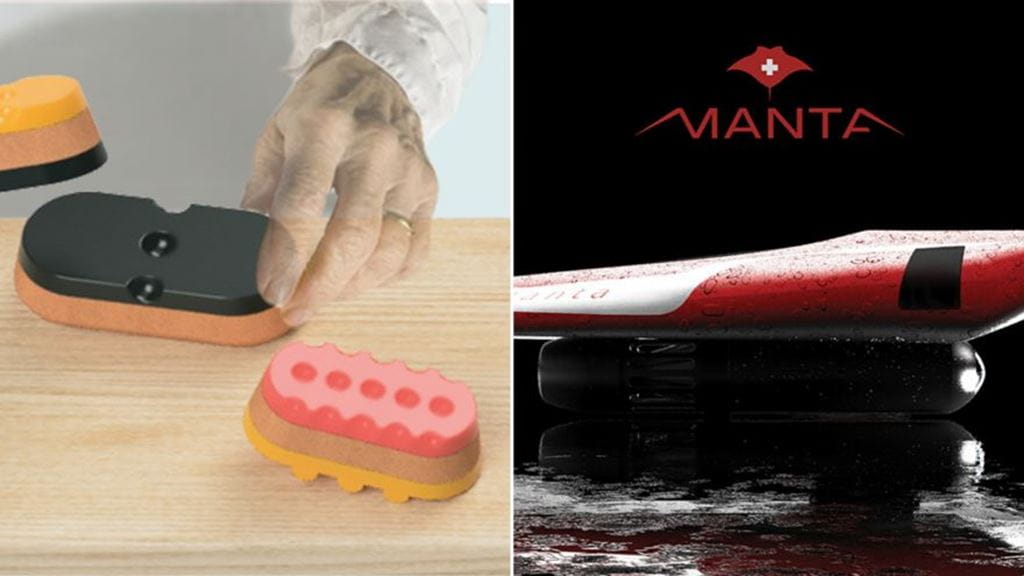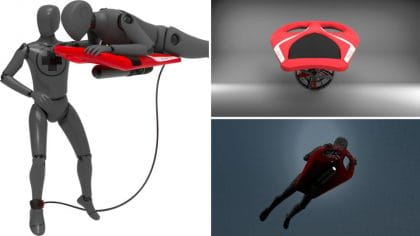
Human-focused solutions by Sheridan Industrial Design students honoured at Rocket Awards
 by Keiko Kataoka – Jun 23, 2020
by Keiko Kataoka – Jun 23, 2020 The Ontario-wide Rocket Competition for graduating industrial designers has been hosted by the Association of Chartered Industrial Designers of Ontario (ACIDO) for the past 19 years. Recently entering into the fray of eligible competitors, alongside its well-established post-secondary counterparts, are students from Sheridan’s nascent Honours Bachelor of Craft and Design – Industrial Design degree. They had a strong showing at the 2020 Rocket Awards, which were presented as a virtual showcase due to the COVID-19 pandemic, with two receiving double honours for their human-centered thesis designs.
Sheridan’s final-year students spend their academic year researching, ideating, iterating through prototyping, and testing, to come to finally producing a physical model and comprehensively documenting the overall process. It’s an in-depth process required of industrial designers and a hands-on experience aligned with what students can expect in the industry.
Finding solutions for people with Alzheimer’s Disease

Quinn MacGowan is the recipient of the ACIDO Rocket second place award and the Entro Design Thinking Award for Al-i, a family of products designed to redirect the negative moods and behaviours of those living with Alzheimer’s Disease.
“I chose to focus on Alzheimer’s because I have a personal connection to it, so I felt passionate about creating products with the goal of enhancing quality of life,” says MacGowan. The three Al-i products include a stacking puzzle – the Al-i Link, a weighted lap pad, the Al-i Lap, and a sensory Al-i Lume light, each suited to a person’s stage on the timeline of the progressive disease.
During her initial research, the health professionals MacGowan spoke to advocated for an uncomplicated product that could provide a sense of accomplishment and offer an outlet for repetitive behaviours, leading to a family of complementary products to address varied needs.

MacGowan produced models of each, using principles of Colour Theory to select warm and grounding palettes for her designs and exploring the principles behind Montessori activities, which she discovered are being utilized for many Alzheimer’s patients. Material considerations included washable silicone, fabric and cork, which has natural antimicrobial and antibacterial properties – important factors for long-term care home settings.
As a degree student at Sheridan, MacGowan opted to take Sheridan’s first-of-its-kind in Canada Board Undergraduate Certificate in Creativity and Creative Problem Solving. “I found that the skills taught in those courses helped me conduct meaningful and insightful interviews with healthcare workers,” she says. “This helped me narrow down the problem area that I wanted to tackle before I started conceptualizing.”
With the ACIDO honour validating the direction of her work with Al-i, MacGowan is eager to continue building working prototypes and conduct proper testing. “A project like this typically spans a couple of years until it is truly market ready,” she says.
A new look at an old design for water rescues

Joseph Clayton is the recipient of the ACIDO Rocket third place award and the Shepp ID Health and Wellness Award for MANTA, an upgraded lifeguard ‘can’ designed to keep the person in distress afloat. Clayton was inspired to conceptualize the device from his own near-drowning experience during a swimming lesson as a child in Indonesia.
MANTA’s design proposes the use of an electric power, water-jet propulsion system integrated into the bottom of a hard-plastic buoy. The assistive device will help the rescuer conserve energy while assisting an incapacitated person by providing a surface on which they can lie.
From his interviews with several lifeguards in North America, Clayton learned of the concerns and limitations of existing tools of the trade and factored those into MANTA’s design.
“My considerations included the bright colours and light-weight materials of existing lifesaving devices, addressing stability concerns of the device by borrowing from the design of a keel of a boat and looking at ergonomics,” says Clayton. “There’s a lot of trial and error involved.” He tested an early prototype in a local swimming pool, receiving constructive feedback from two lifeguards.

Clayton was drawn to Industrial Design for the varied skills it requires and a flexibility in career streams. “You need to understand materials, manufacturing and rely on skills like creativity and problem-solving when designing,” he says. “I’m eager to get back into a studio so I can refine MANTA. There’s always room for improvement as a designer, which can be both frustrating and satisfying.”
A highlight of Clayton’s Sheridan experience in the tight-knit cohort is guidance not only from industry-connected professors, but his peers. “My classmates deserve mention,” he says. “We constantly gave each other feedback. It helps keep you motivated having all of that support and seeing your peers working hard on their projects.”
Sheridan’s Industrial Design degree measures up
Industrial Design professor and program coordinator Scot Laughton is thrilled by the recognition of students from the program’s third-ever graduating class. “Our four eligible students for the 2020 Rocket Competition all put forward highly thoughtful and well-developed design concepts,” he says. “The work from Quinn and Joseph was a phenomenal display of how designers can truly impact people’s lives.”
MacGowan and Clayton winning two of the top honours among 150 graduating students’ work is a great achievement, says Laughton. “Their success is a gauge for how well the program is developing and establishing itself. The students and faculty should be proud.” Laughton and fellow Industrial Design instructors Doreen Stegmuller and Thang Tran advise the fourth-year cohort of 18 students, providing expert guidance, helping to shepherd projects from research to finished product.
Newly graduated, MacGowan’s ambition is to become a Human Factor designer – a role that applies psychological and physiological principles to creating products. “I consider myself an empathetic, human-focused and emotional designer,” she says. “It’s important to not make any assumptions about the users’ needs or wants and to ask lots of questions.”
Clayton hopes to work in military, designing products like safety gear. Reflecting on his Sheridan journey he says: “When I was in first year, I would look at the work of fourth years and think ‘wow, that’s amazing. I’m no good.’ Now I see work of people I admire and think, ‘I can do that.’ You must spend the time, put in the hours, and never stop working to hone your skills.”
Pictured at top of page: Quinn MacGowan’s Al-i devices (left) and Joseph Clayton’s MANTA device (right).
Written by: Keiko Kataoka, Manager, Communications and Public Relations at Sheridan.
Media Contact
For media inquiries, contact Sheridan’s Communications and Public Relations team.



